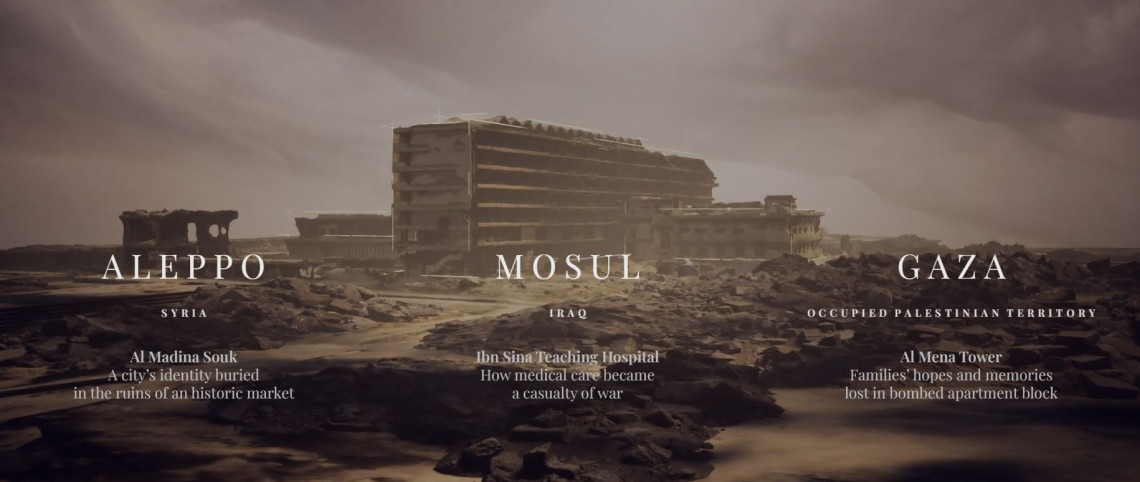
‘Broken Cities’: 35,000 layered photos of war-ravaged buildings expose the hidden costs of urban conflict in first-of-its kind photogrammetric project
This powerful digital experience from the International Committee of the Red Cross takes viewers on a journey through 3D models of Mosul Ibn Sina Teaching Hospital, Aleppo's Old Bazaar, and a housing tower in Gaza, a region that has endured massive levels of destruction in recent weeks due to urban warfare. Users witness the stories of endurance, solidarity, and revival that emerge from the rubble.
Through captivating storytelling and multimedia exhibits, "Broken Cities" puts viewers in direct contact with the personal narratives of survivors. Feryal, Faiz, Satha, Safwan and others share their struggle to rebuild shattered lives long after the fighting has ceased.
“Broken Cities” relies on photogrammetry, one of the most powerful and accurate surveying technique that exists today. The thousands of overlapping photographs were taken by drones and handheld cameras, ensuring every angle and detail of each structure was captured.
“This unique project pays tribute to civilian survivors and offers a profound window into the human cost of war,” said Fabrizio Carboni, ICRC’s regional director for the Near and Middle East. “While cities like Aleppo, Gaza, and Mosul make headlines in war, the long-term needs and ongoing challenges faced by their residents rarely make news. ‘Broken Cities’ urges us to confront the hidden human toll of war in cities and the urgent need for change.”
By shining a light on the role of authorities and the international community in minimizing civilian suffering, "Broken Cities" aims to inspire empathy and action among viewers
When conflict rages in urban areas, the devastating harm inflicted upon civilians is undeniable. Yet, efforts to address the humanitarian consequences have fallen short. "Broken Cities" calls for a commitment to protecting civilians, to emphasizing the importance of respecting international humanitarian law and to avoiding the use of heavy explosive weapons in populated areas.
By combining photography, technology, and immersive experiences, "Broken Cities" creates a captivating journey that fosters understanding, introspection, and meaningful change. It serves as a catalyst for individuals, communities, and policymakers to reassess their roles in creating a safer space for civilians, even at the worst of wartime.
About "Broken Cities":
Broken Cities employs cutting-edge photogrammetry, a noncontact, nondestructive technique, that precisely captures the dimensions and features of spaces and objects through some 35,000 photographs.
Broken Cities 3D models were created on the basis of photographs taken by ICRC field teams during the summer of 2022, using drones and handheld cameras, ensuring every angle and detail of each structure was captured.
This work predated the October 2023 escalation in violence in Israel and Gaza. At the time of publication, the Al Mena tower is still standing but we are still trying to establish whether the people interviewed in Gaza are still alive.
- “Aleppo Old Bazaar, Syria: A city’s identity buried in the ruins of an historic market” highlights the lasting struggles of entire communities, years after the destruction of the city’s economic, social and cultural hub.
“The elders say it’s too late for them to rebuild and restart their business. They hope their sons will do it. Everything in life dies, but not the Souks, they always come back to life.” Hasan Ahmad Swaidan, Souk shop owner - “Mosul Ibn Sina Teaching Hospital, Iraq: How medical care became a casualty of war”focuses on the lasting impact of destroying the city’s largest hospital on public healthcare.
“Not all people can afford to pay the fees of private hospitals or to go outside the city. That’s why we reset the Ibn Sina hospital from scratch. Our ultimate goal is to serve our people in the city.” Dr. Faiz Ibrahim AL-Hamdani, Director of Ibn Sina Teaching hospital
- “Housing Tower in Gaza: Families’ hopes and memories lost in bombed apartment block” sheds light on the mental toll that homelessness, destitution, displacement and fractured support networks takes on people, through the lens of the hostilities of May 2021.
“Everything was buried under the rubble. I lost hope in everything. I will not be able to start from scratch. I lived in this flat for nearly thirty years. My lifelong investment is gone. It was all flattened out, as if it were never there. All my memories were buried. Memories of all my life, everything I remember was in my home.”Feryal Al-Sayegh, owner of an apartment in the Al-Mena tower
Delve into Broken Cities immersive experience at broken-cities.icrc.org
Media Contact:
Christoph Hanger, ICRC Geneva, changer@icrc.org , tel: +41 79 731 04 03
Jason Straziuso, ICRC Geneva, jstraziuso@icrc.org , tel: + 41 79 949 35 12
Suhair Zakkout, ICRC Damascus, szakkout@icrc.org, tel.: +963 930 336 718
